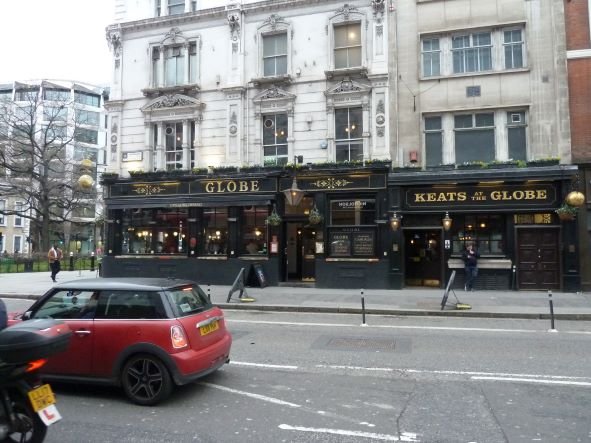Keats’s early life in Moorgate
No one is certain where John Keats was born, but it was probably in the Moorgate area of London.
His maternal grandfather, John Jennings, leased the Swan and Hoop, a stables and coaching inn at 22-24 The Pavement in Moorgate. The inn catered for people travelling into the city. Keats’s father Thomas worked as an ostler there and in 1794 married John’s daughter, Frances Jennings. Their first son, John Keats, was born on 31/10/1795, possibly at the inn or nearby. The Swan and Hoop was demolished but today the Globe Inn stands on the site.
Keats spent his early years living just north of the inn at Craven Street and his brothers George and Tom were born there. In 1802 John Jennings retired to Ponders End in Enfield (where apothecary surgeon Thomas Hammond attended him) and his son-in-law Thomas Keats took over the lease. The Keats family moved to the inn.
The Swan and Hoop was just north of London Wall, which demarcated The City of London. By this date the city gate at Moorgate had been demolished. To the north were fields and countryside. Nearby is the site of the first manned hot air balloon flight in England by Italian Vincenzo Lunardi on 15/9/1774 from the Artillery Ground.
Opposite the inn, to the east, lay Moorfields, an open area where pie sellers offered their wares and children played. The Bethlem Royal Hospital for the mentally ill, commonly known as Bedlam, faced north towards the Moorfields. At its entrance two giant statues by Caius Cibber topped the gateposts. They had bald heads, one face in agony the other blank. These were Raving and Melancholy Madness, the two types of mental illness recognised at the time equating to mania and depression today. (They are now on display at The Bethlem Museum of the Mind in Beckenham, Kent).
Statues of Raving Madness and Melancholy Madness at The Bethlem Museum of the Mind, Beckenham, Kent
Bedlam was made of red brick and its front was over five-hundred feet long. It had three white towers, three floors and hundreds of small, identical windows. It was often compared to a palace. The building was grand, designed to impress and also intimidate. The treatment of madness was a grand project. Behind it rose the spires of London churches and the smoke of the city. Some pictures of Bedlam show the Swan and Hoop, a three-storey building, in the background. Bedlam was demolished in 1815. Finsbury Circus now stands on the site. The hospital moved south to St George’s fields in Southwark (now the Imperial War Museum) then moved again to Kent in 1930.
In Keats’s time Moorgate was a poor area. It’s arguable whether he was working class or middle class but he definitely wasn’t from the aristocracy as many poets of the time were. Today Moorgate is a busy area of London, around Moorgate station. It has many tall buildings and is part of the financial district. A blue plaque on the pub Keats at the Globe marks the site of the Swan and Hoop.






